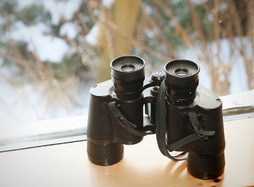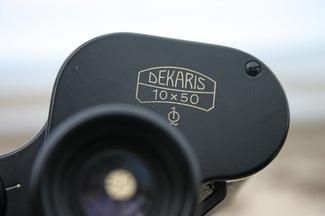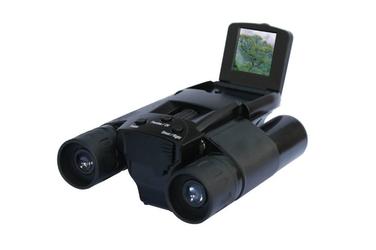The Intro
The Look

The Looking Glass

The Historical Look

The Look Ahead

The Intro
How do you pick a pair of binoculars? If you have unlimited funds and don’t mind carrying a large set of glasses around, it will be easy to choose. For those of us that have a budget and don’t need the night vision, there are still choices. There are more styles of binoculars than a person can count and they come in all manner of different sizes, shapes, quality, optics and price range. Read on and we can sort out what might be right for you while leaving some pennies in your pocket.
The Look
There are small sets of binoculars that are used for sporting events and operas and medium to large size sets that usually sit on a sill to a backyard window, but bigger is not always better when it comes to your optical assistance. The smaller binoculars are very easy to carry around and stow away but the downside is that these are usually not that great for magnification or light. There are the standard sets of binoculars which are the very same ones that you might find on a Boy Scout outing and they are the ones that I started my glamorous bird watching career with. This what you would call the Goldie Locks set, not to big, not to small ………. and you know the rest. There are larger pairs of glasses that allow a good deal of light in due to their large lense openings, but sometimes these can be very bulky. With the introduction of digital, you can view your subjects on a screen or record the image. What ever the look, you want something that fits your needs and the question is, what exactly do you want to do with them?
The Looking Glass
What are Optics? The optics refer to the way the light is manipulated in the binoculars and then sent to your eyes. I am not going to bore you with the full scientific explanation, but there are two things that you should be aware of in a standard set of binoculars. Those are, the magnification and the amount of light allowed into the lens from your subject. Have a look at the photo, there are two numbers on a set of binoculars that usually look like this: 10x50. The first number is the magnification and the second is the size of the opening the lens sits in. Simply put, the larger the first number is, the larger the object will be in the binoculars view. The larger the second number, the easier the object will be to see in low light. An 8 magnification would be the least amount I would recommend for birding and 32mm would be the smallest opening which allows to see the details of the bird. I use a pair with 10 magnification and a 42mm opening and they suit my needs very well for the birding I do. If you wnat to get closer, there are spotting scopes.
The Historical Look
Binoculars are essentially two sets of telescopes strapped together. Hans Lippershey, from Holland, is generally claimed to have invented the concept of the binocular, however, the concept may have been built previously by several others. The idea was to have a person be able to receive the larger image in both eyes at the same time in the same view. This pair of optical tubes made it simpler to see your target without closing an eye. The two telescope concept does make it a little difficult if you want to head out for a walk leaving two long tubes hanging off your neck and of course you would now you need 4 hands to steady the contraption. This is where the first part of the invention comes in handy. An inventor by the name of Porro invented two prisms that would not only turn the image right side up but also enable the whole scope to be shortened. Binoculars started becoming mainstream with the German duo of Ernest Abbe and Carl Zeiss who’s concept of a cemented prism telescope and a new and innovative design quickened the production in the late 1800’s. The company that Zeiss built is still selling quality lenses today.
The Look Ahead
Just like everything else, binoculars have been equipped with some very cool advances. These advancements are the real thing and not just something 007 would add to his arsenal when he is down chatting with Q. Some of these new gadgets include digital recording of stills or movies directly within the binoculars, night vision, . A few of these have the capability to record straight to your smart phone. You can post your photo to Facebook of a bird that you need help identifying or possibly that one rare bird that no one else saw. All of this can happen within a couple minutes of seeing the bird in a swamp 50 miles from home computer. There are binoculars that have night vision which allow you to get good looks at our night-time dwellers like owls and nightjars. The are no longer your grandpa’s binos.
The Cost of Looking
The cost of this little devils are as varied as the style. There are beginner’s binoculars that are as little as $10.00 but glasses that suit the serious birder will be in the hundreds of dollars. A decent pair that you might keep on the counter or the back porch to view your feeders might cost you in the range of $30-$60. I use a very sturdy pair of bins, (short for binoculars,) which are currently selling for around $200. These Diamondback binoculars are made by Vortex and come with an amazing warranty. I am not gentle with my gear so this gives me piece of mind and when I am making my way through heavy brush in search of that next lifer. Some of the more expensive versions can run into the thousands for high end optics or the special features like night vision. But you can get a decent set of electronic binoculars with a view you can record for around $100. Dont forget if you are going out into the great outdoors that a harness is a must have to keep your hands free. The first time I used a harness, it changed my birding. The harness I use is around $30. I have included several choices here or check out our Birding Store for other types, styles and price ranges.
The Finish
There are a tremendous amount of choices when it comes to binoculars, but this short look at binoculars should shed some light on your view, all pun intended. Besides a little bit of history, I hope you have a better idea of what different bins might suit your needs. If you are looking for a set that is for the feeder, out the back window, you may only need the standard set, however, if you are looking to record that beautiful or rare visitor that you came across in the park, now you know you have some options. I will leave you with a saying of mine. May all your birds be rare and your binoculars steady.
7 Comments
Anne Roberts
5/11/2017 09:05:03 am
What a great article! I love the site!
Reply
5/22/2018 04:08:38 am
This is such an informative post. You have a lot of really great points. I wish I had this post as a resource when I started blogging.
Reply
11/16/2018 09:46:04 am
Thanks for the nice comment John. The Vortex Diamondbacks are great binos. The difference in price will be the difference in optical resolution. 10x28's are fine for a starting pair though which would be the most economical. I have a pair of 10x42's
Reply
11/16/2020 07:46:39 pm
I am in essence astonished by the way you certain out almost every single little detail.
Reply
I am looking for some good blog sites for studying.<a href="https://www.gf-avatar.com/" title="온라인카지노"alt="온라인카지노"target="_blank">온라인카지노</a> I was searching over search engines and found your blog site. Well i like your high quality blog site design plus your posting abilities. Keep doing it.
Reply
Leave a Reply. |
|
Go Birding Today
|